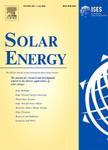版权所有:内蒙古大学图书馆 技术提供:维普资讯• 智图
内蒙古自治区呼和浩特市赛罕区大学西街235号 邮编: 010021

作者机构:Univ Jordan Sch Engn Mech Engn Dept Amman 11942 Jordan
出 版 物:《SOLAR ENERGY》 (Sol. Energy)
年 卷 期:2025年第287卷
核心收录:
学科分类:0820[工学-石油与天然气工程] 080703[工学-动力机械及工程] 08[工学] 0807[工学-动力工程及工程热物理]
主 题:PV module Passive cooling Forced water circulation Heat exchanger TRNSYS
摘 要:Photovoltaic (PV) module efficiency decreases as the module temperature increases. Cooling PV panels enhances efficiency by reducing resistive losses, improving carrier mobility, reducing thermal stress, and increasing fill factor. In this article, a forced water circulation method is introduced to cool the PV module results in lowering its temperature and consequently increasing module productivity. This method uses a copper pipe heat exchanger (HX) attached to the back side of the PV module with forced water circulation. This cooling method is passive, cheap, simple and effective configuration especially in large scale plants. An experimental approach was conducted using two identical PV modules, one cooled and the other is not, to investigate the impact of cooling process system on module productivity in Jerash City-Jordan weather conditions. Experiments were conducted over six consecutive days, and results were compared with TRNSYS software. It was found that our method of cooling the PV panels results in average temperature reduction of 4.62 degrees C that corresponds to 9.55%, average power enhancement of 8.08% and efficiency of 10.41%. TRNSYS simulated results confirms the experimental results trend with average power enhancement of 11.87% and efficiency of 10.05%. Experimental results demonstrated a significant increase in energy production, with the cooled module generating 377 Wh more electricity than the non-cooled module. The cooling system is feasible based on the productivity enhancement and prolonging the panels lifespan.